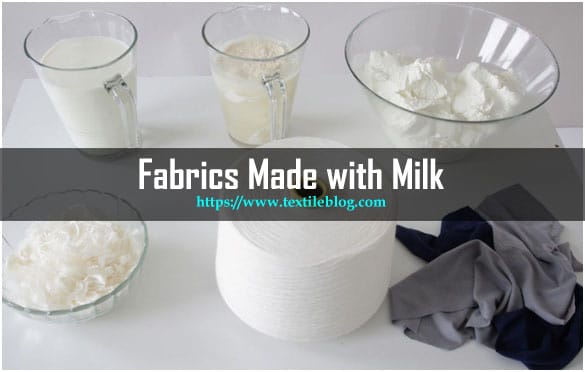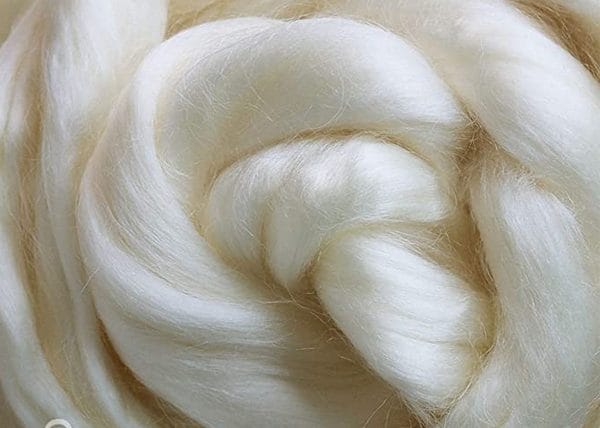Fabric made with milk:
Milk or Casein fiber has been around for almost a century but has recognized as ecological material. After learning about traditional production methods for this textile, Anke Domaske, founder of the German company Qmilk, set up a new friendly manufacturing process. Fabric made with milk is non-allergenic, silky & is attracting interest outside of the fashion world.
The method worked out by the European designer consists in extracting the protein contained in milk, then mixing it with water to make a paste. The most effective milk for this method is cow’s milk which has expired: it is, thus, easier to extract the protein. By reusing spoiled milk, it is thus possible to reduce food waste, a major environmental and social problem.

The dairy industry
Although the milk industry has a considerable environmental impact, a study by Cornell University estimates that it is less polluting than it was in the 1940s, with a significant decrease in the resources used per volume of yield. But, the decrease in the number of animals and the area exploited seems to be able to translate into an increase in productivity imposed on dairy cows and a reduction in their living space. Thus, the production of this animal drink, which has now become intensive, has large environmental impacts. To produce milk fiber, an organic alternative, as well as the use of expired milk, are thus more ecological and ethical options.
Milk fiber: an ecological material
Even if the dairy industry has environmental and ethical drawbacks, the new protein fiber manufacturing process requires only the greatest of two liters of water to produce one kilogram of textile, which represents a significant ecological advantage. The Qmilk factory operates on renewable energies and aims to produce residues that are close to “zero waste”. Also, milk production requires no pesticides or chemical fertilizers, unlike cotton, which remains one of the most used materials in the fashion industry. Since the milk, fiber absorbs color well, very little dye and water required for its coloring, and since it is white, its production does not must any abrasive bleaching agent.

A high quality alternative
Besides being an ecological choice, textiles made with milk are of superior quality: not only are they very resistant and durable, but they absorb moisture well. Milk fiber looks a lot like silk and wool: it is light, soft and thermoregulatory, which means that we will not be sweaty on warmer days! To the delight of ecologists, textiles made from milk are compostable 1 and, to please the laziest of us, they can be machine washed! The fiber also has antibacterial and antifungal properties, so there’s no chance the tissue will infest with bacteria or fungi.
A 100% natural process
The manufacturing itself is a natural process, without pesticides. No chemicals or petroleum products used in this creation process, the impurities removed from industrial milk of inferior quality and unfit for consumption. Then, casein obtained at a temperature of 80 degrees. The much-adulated protein added to water and also other natural elements. The recipe remains confidential. The result appears in the form of a fine fiber. This system is ecological in all respects since it consumes little energy, little water required, unlike many other fabrics.
Properties of milk fiber:
It is ecological-
- Amino acids in protein are antibacterial.
- Anti-aging
- It helps saline circulation
- Regulates body temperature
- It’s fairly soluble in water
Properties comparison of Casein, Cotton and Wool:
| Property | Casein | Cotton | Wool |
| Length (mm) | 38 | 25-39 | 58-100 |
| Fineza (dtex) | 1.52 | 1.2-2.0 | 6-9 |
| Dry Strength Resistance (cN / dtex) | 2.8 | 01.09 to 03.01 | 0.206 to 03.05 |
| Dry Break Elongation Rate (%) | 25-35 | 7-10 | 14-25 |
| Resistance To Traction In Wet (CN / dtex) | 2.4 | 3.2 | 0.8 |
| Extension Rate At Wet Breakage (%) | 28.8 | 13 | fifty |
| Coefficient of Friction (dynamic) | 0.214 | 0.26 | 0.384 |
| Coefficient of Friction (static) | 0.187 | 0.24 | |
| Logarithm of Specific Mass Resistance (Wg / cm2) | 9.1 | 6.8 | 8.4 |
| The Initial Module (CN / dtex) | 60-80 | 60-82 | 44-88 |
| Moisture Recovery (%) | 5-8 | 7-8 | 15-17 |
| Specific Weight (g / cm 3) | 1.22 | 1.50-1.54 | 1.34-1.38 |
Undeniable assets
With a cost price exceeding that of cotton, the fiber in milk protein is but less expensive than silk, while having the same properties. Indeed, this textile has a panoply of positive points: hypoallergenic, resistant, antibacterial and antistatic. Combining the strengths of natural and synthetic fibers, milk fiber has a completely reduced ecological impact! It is recyclable and suitable for compost, an extraordinary challenge!
The fabric offers a soft, smooth and comfortable texture, comparable to the touch of silk. It respects your skin and protects it from any irritation.
Sumptuous creations
With a silky fabric resistant to bacteria, the German researcher launched ultra-trendy and elegant clothes from the udder of the cow. The textile is machine washable and biodegradable, it is an intelligent fabric which warms you during the winter frost and brings you a very pleasant freshness in summer. In fact, Anke Domaske launched an innovative collection of magnificent dresses, with the Mademoiselle Chi Chi brand.
The designer plans to develop her baby in hospitals, automotive and furniture industries. It has already seduced an Italian paper manufacturer Lucart, with the design of a luxury toilet paper.
She knew how to use an abundant raw material and in overproduction within her native country, for a remarkable product, hat for her inventiveness!
Industrial opportunities in perspective of milk fiber
Fabric made with milk is used in ready-to-wear, milk fiber gives clothes that have the particularity of being compostable and biodegradable when they are no longer used.
But the fashion industry is not the only outlet, because this fabric has antibacterial, antistatic and hypoallergenic properties which are also of interest to the medical sector. In Japan, for example, milk fiber used for hospital bed linen. In the long term, car manufacturers and furniture manufacturers could also offer other interesting opportunities.
The cost of milk fiber remains high, but, up to that of silk: hence the importance of finding other outlets than the fashion industry. A virtuous challenge for a production that is both ecological and ethical.
References:
- https://textilelearner.net/milk-or-casein-fiber-properties/
- https://www.textiletoday.com.bd/properties-production-use-milk-fiber/
- https://sewport.com/fabrics-directory/milk-fabric
- https://www.origamiorganics.com/en/c/6-milk-fiber
- https://www.made-in-china.com/products-search/hot-china-products/Milk_Fiber_Yarn.html
- https://blog.thedpages.com/qmilch-a-revolutionary-milk-fiber-proves-a-recipe-for-style/
- https://www.popsugar.com/family/Miniature-Milk-Baby-Clothing-Made-Milk-Fiber-22164123
Author of this Article:
Md. Raisul Islam Rifat
Dept. of Textile Engineering
Daffodil International University, Dhaka
Email: ririfat750@gmail.com
